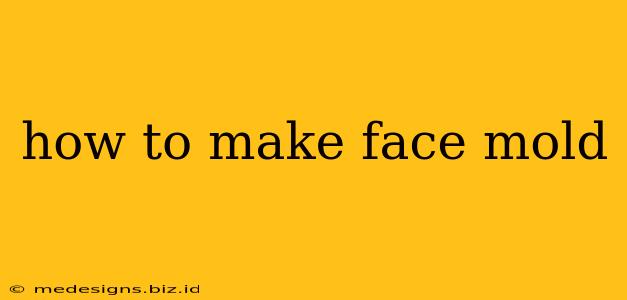Creating a face mold might sound daunting, but with the right materials and techniques, it's a surprisingly achievable project. Whether you're a sculptor, special effects enthusiast, or simply curious about the process, this guide will walk you through the steps to safely and effectively make a face mold. We'll cover different methods and crucial safety considerations.
Choosing Your Method: Alginate vs. Plaster
There are several ways to make a face mold, but two popular methods stand out: using alginate and using plaster bandages. Each has its own advantages and disadvantages.
Alginate Mold Making
Alginate is a seaweed-based material that's non-toxic, relatively inexpensive, and easy to use. It sets quickly and creates a detailed, flexible mold. This makes it ideal for capturing fine facial features.
Pros:
- Safe and non-toxic: Suitable for use on skin.
- Easy to use: Requires minimal skill and equipment.
- Detailed results: Captures fine facial features accurately.
- Flexible mold: Easy to remove from the face.
Cons:
- Short working time: Requires quick application.
- Can be messy: Requires careful handling.
- Not durable: Not suitable for long-term use or multiple castings.
Materials Needed:
- Alginate powder
- Water
- Measuring cup and bowl
- Mixing stick
- Release agent (Vaseline or petroleum jelly)
- Container for mixing
- Something to support the model's head (e.g., a headrest or chair)
- Plaster of Paris (for creating the positive cast from the alginate mold)
Step-by-Step Process:
- Prepare the model: Apply a generous layer of petroleum jelly to the face, ensuring all areas are covered to prevent sticking. Protect hair with a cap.
- Mix the alginate: Follow the manufacturer's instructions carefully for mixing ratio of alginate powder and water. Mix thoroughly to avoid lumps.
- Apply the alginate: Quickly and smoothly apply the alginate mixture to the face, working from the forehead down. Keep the application even to avoid thick or thin spots.
- Wait for setting: Allow the alginate to set completely (this usually takes a few minutes).
- Remove the mold: Gently peel the alginate mold away from the face, starting at the edges.
- Create the positive cast: (Optional, but recommended) Pour plaster of Paris into the alginate mold to create a more durable and reusable positive cast.
Plaster Bandage Mold Making
Plaster bandages offer a more durable and reusable mold, suitable for multiple castings. However, they require more skill and are less forgiving than alginate.
Pros:
- Durable and reusable: Allows multiple castings.
- Stronger mold: Less prone to damage.
Cons:
- More difficult to use: Requires more skill and precision.
- Less flexible: Can be more challenging to remove.
- Requires more materials: Increased cost compared to alginate.
- Less detail: May not capture as many fine facial features.
Materials Needed:
- Plaster bandages
- Water
- Scissors
- Bowl of water
- Petroleum jelly
- Something to support the model's head (e.g., a headrest or chair)
Step-by-Step Process:
This process is more complex and requires further research as it involves multiple layers of bandages and careful placement to ensure the mold's integrity. Consult detailed tutorials specific to plaster bandage mold making before attempting this method.
Safety Precautions
- Allergic reactions: Always test a small amount of alginate or plaster on a small area of skin before applying it to the face.
- Breathing: Work in a well-ventilated area to avoid inhaling plaster dust or alginate fumes.
- Skin sensitivity: Apply a thick layer of petroleum jelly to protect the skin.
- Proper support: The model must be comfortable and still during the molding process.
- Removal: Be gentle when removing the mold to avoid causing discomfort or injury.
Remember, practice makes perfect. Don't be discouraged if your first attempt isn't flawless. With patience and attention to detail, you'll create stunningly accurate face molds. Always prioritize safety and comfortable model positioning.
